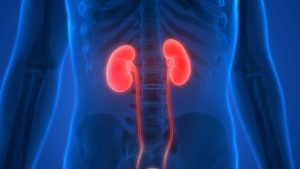
Steroid-resistant nephrotic syndrome – causes, side effects and treatments at NaturalPedia.com
Friday, July 27, 2018 by Ralph Flores
http://www.naturalpedia.com/steroid-resistant-nephrotic-syndrome-causes-side-effects-and-treatments-at-naturalpedia-com.html

Steroid-resistant nephrotic syndrome (SRNS) refers to a rare kidney condition which retains excess fluid in the body.
A person with SRNS will typically see swelling (edema) in the face, eyelids, and ankles. In particular, facial swelling is evident in the morning, while ankle swelling is worse in the evenings – or after standing. The characteristic swelling in SRNS is soft and puffy, with a light press leaving a dent in the skin. If the edema is extensive, it can affect the abdomen and hands, which can increase body weight and cause a feeling of tightness.
SRNS increases a person’s risk for infection, as well as blood clots in the legs.
Neonates who develop SRNS could mean that the condition is genetic, and other members of the family may either be carriers of the mutant gene or are affected in some way.

Known symptoms of steroid-resistant nephrotic syndrome
Typical symptoms of SRNS include:
- Edema – fluid retention
- Focal segmental glomerulosclerosis – scarring in the kidney filters
- Hyperlipidemia – high levels of cholesterol, fats, and triglycerides in the bloodstream
- Hypoalbuminemia – low albumin levels in the blood
- Proteinuria – high levels of protein in the urine
- Stage 5 chronic kidney disease (CKD) – advanced impairment of kidney function
Body systems affected by steroid-resistant nephrotic syndrome
The primary organ affected is the kidney, but symptoms can affect the whole body.
Food items or nutrients that may prevent steroid-resistant nephrotic syndrome
Little information exists on diets to prevent SRNS; however, healthcare professionals will suggest a diet with specific amounts of protein, sodium, and potassium for people with existing kidney conditions to prevent it from getting worse.
- Protein – While it is essential for cell development, people with kidney conditions such as SRNS cannot handle that much protein. Keeping carbohydrates and fats in check with your protein can help the body get the nutrients it needs despite the limitations.
- Sodium – Aside from raising blood pressure, sodium can also retain fluids, which makes SRNS worse. One way to limit sodium is to cut off eating processed foods and check labels for salt content.
- Potassium – Limiting potassium levels in the body will ensure that the heart rhythm is not affected by the disease.
Treatments, management options for steroid-resistant nephrotic syndrome
Currently, no cure exists for SRNS. The condition is rapid and progressive, with patients easily reaching CKD 4 and require dialysis.
Where to learn more
- Try This Amish Remedy For High Blood Pressure
- Misdiagnoses rampant among psych drug users; children with digestive problems being labeled schizophrenic, drugged with deadly SSRIs
- Antibiotic widely prescribed for decades has dangerous side effects which can kill
- Hepatitis B Vaccine: Good for ‘Newborn’ Prostitutes and Drug Users, but Who Else?
Summary
Steroid-resistant nephrotic syndrome (SRNS) is a rare kidney condition which retains excess fluid in the body. This can be seen in the face, eyelids, and ankles. If the edema is extensive, it can affect the abdomen and hands, which can increase body weight and cause a feeling of tightness.
SRNS increases a person’s risk for infection.
SRNS primarily damages the kidney.
A diet with specific amounts of protein, sodium, and potassium for people with existing kidney conditions to prevent SRNS from getting worse.
Sources include:
Tagged Under: Tags: Steroid-resistant nephrotic syndrome





